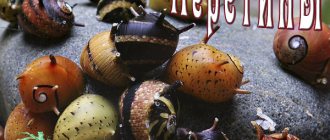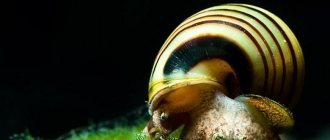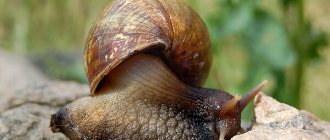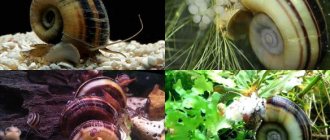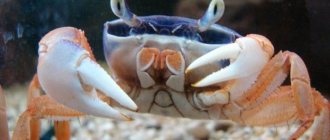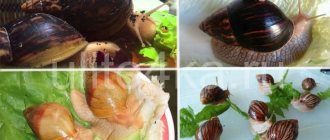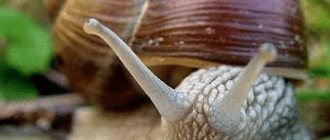Very amazing and interesting representatives of mollusks in our aquariums are Helena snails (Anentome Helena). These are quite beautiful and attractive inhabitants of the aquarium. These yellow-striped representatives of the reservoirs of Thailand, Indonesia and Southeast Asia are unpretentious in keeping, feeding and breeding. It can be said about them, like many aquarium mollusks, that they do not require personal care. The water parameters are typical, as for all tropical aquariums: temperature 25, neutral acidity 7, higher hardness. The most important thing is that there are no excessive concentrations of nitrogen compounds in the aquarium.
Helena snail
The size of Helena snails is 0.5 - 1 cm. The body of the mollusk is elongated, the head and legs have a trunk-like shape.
In addition to their decorative properties, Helena snails have a very interesting feature - they are predators and feed on animals (protein foods). Unlike many other freshwater snails, they do not eat plant matter.
This amazing property of Helen is perfectly used in the fight against such small snails as: melania, coils, fisa , pokemon . The Helens attack and destroy them. Thus, we can naturally biologically control the number of snails, which breed like rabbits. Yes, this process is not as fast as using snail preparations (copper sulfate), but it is natural.
We recommend viewing
Striped headhunters are inexpensive, about 30 rubles per shell. In an aquarium up to one hundred liters, five helenas are enough. Thus, all you need to do is save 150 rubles from the family budget, go to the pet store, collect minke whales and throw them into your aquarium. That's all. Then you just wait for Helen to report on the work done. In approximately a couple of months there will not be a single coil in your aquarium.
Note that Helenas are loyal to larger snails, such as, for example, ampullaria. However, cases have been noted and there is a lot of evidence on YouTube that a horde of Helens can easily overwhelm a large slug. In addition, Helena is able to catch, press against the wall and give her death kiss to a small beauty, for example, a cherry.
This is the conclusion, friends. If you are going to keep the ampoule with helenas, then only with large ones. Helena's small ampoules will be hamstered 100%. On the issue of compatibility with shrimp, hmm... we don’t know, they live quietly with cherries and Amano shrimp. There were no incidents.
Habitat in nature
The Helena snail is known by two Latin names: Clea Helena and Anentome helena. The latter classification places it in the Anentome family.
This species is found throughout Southeast Asia, especially in Malaysia, Thailand and Lake Toba on the Indonesian island of Sumatra. Anentome helena may pose a serious threat to native freshwater gastropods in countries where they have been introduced.
Like all snails in the Neogastropoda clade, this species is carnivorous. In nature, they are predators that feed on both live snails and carrion, and this is what made them very popular in the aquarium. These snails often feed on larger snails, often burrowing and ambushing their prey.
Most helenas love running water, but can live in lakes and ponds, which is probably why they adapt well to aquarium conditions. In nature, they live on sandy or muddy substrates.
Diseases and prevention
The most common pathology is a breakage of the shell or part of it. The reason may be a simple fall on a hard surface, as well as the inattention of the owners. Subsequently, the snails develop holes in the shell, the growth breaks, crevices of various shapes form, and the apex breaks off.
The presence of cracks indicates a lack of calcium; for their speedy healing, the victim should be provided with rest, proper nutrition and the necessary conditions; in extreme cases, plaster is applied.
If the first turns of the shell break off, but the snail feels good, then it’s okay. When internal organs fall out, repair is done using calcium sulfate hydrate. A broken growth does not pose any threat; within a few days it will recover on its own; for this you just need to feed it more calcium. A white coating on the shell indicates improper maintenance of the mollusk; to eliminate it, it is necessary to reconsider the situation. It may also indicate old age or simply wear and tear; there is no point in fighting these reasons.
Description
This snail typically grows to 20-35mm in length, depending on food sources, usually smaller in the aquarium. The shell, which is conical in shape, often consists of dark brown and yellowish-brown stripes. Some specimens come with completely brown shells, devoid of edging.
The shell is conical, ribbed, the tip of the shell is usually absent. The shell color is yellow, with a spiral stripe of dark brown. Body grey-green.
Life expectancy 1-2 years.
Helen's benefit
The predatory abilities of these mollusks are successfully used by aquarists to adjust the number of small snails, which literally multiply exponentially.
Helenas naturally (biologically) destroy populations of small mollusks. In the absence of Helen, aquarists have to catch snails by hand or use chemicals that:
Negatively affects the health of the fish. Copper, present in chemical preparations, is harmful to fish. This microelement also disrupts the biobalance of the aquarium environment.- They provoke mass mortality of “weedy” snails. The global shellfish pestilence also has a bad effect on the state of water. It becomes polluted with a large amount of dead organic matter and increases the levels of nitrates, ammonia and nitrites. As a result, the owner of the jar has to siphon (clean) the container, filter the water and use zeolite and activated carbon.
Helenas are freed from such efforts and become ideal “cleaners.” Moreover, they do not harm aquatic plants, other large snails, fish, crayfish and shrimp at all.
Keeping in an aquarium
Helenas are very hardy and easy to keep.
Like most other snails, they will not do well in water that is too soft, as they need minerals for their shells. Although water parameters are not too important, it is better to keep them in medium-hard or hard water, with a pH of 7-8.
These snails are freshwater and do not require salted water. But they tolerate lightly salted food quite well.
This is a species that burrows into the ground, and it requires soft soil, sand or very fine gravel (1-2 mm), for example. Such soil creates conditions that are as close as possible to real ones, since after eating they burrow into the ground completely or partially .
They will also be more willing to breed in an aquarium with soft soil, because the young immediately burrow into the world after hatching and then spend most of their time in the soil.
Reproduction
The Helena snail is not a hermaphrodite. In order to achieve success in reproduction, you need to keep a large number of mollusks, since it is impossible to determine the gender of a particular individual by eye. With a large number of snail-eaters, there is every chance of raising a sufficient number of different-sex young animals.
Development of helena from eggs.
Stages of reproduction
- Formation of a couple. Two mollusks of opposite sexes form a pair and begin to mate. For Helen, the mating process can last several hours. Other mollusks may also join the pair. Sometimes the whole group sticks together.
- Laying eggs. A female individual lays only one egg on the surface of a stone or driftwood.
- Embryo development. This is quite a long process. Depending on the conditions, it can last from three to four weeks.
- The birth of a predatory mollusk. After the small predator hatches from the egg, it immediately falls to the bottom of the aquarium and buries itself in the ground for several months.
- The period from birth to puberty. From the moment the egg appears to the discovery of a young individual in the aquarium, about six months pass. Young mollusks emerge from the shelter after they reach a size of 8 mm.
Not all young mollusks reach 1 cm in size, when an individual can be considered an adult. Most of the young become victims of cannibalism and die in the struggle for food during the period when they live in the ground. Adult helenas do not eat small individuals.
Speeding up the process
One of the main conditions for the successful reproduction of predatory snails is water temperature. The optimal option is 23-25 °C. If the thermometer drops below 20, then the reproduction of mollusks stops.
It is better to keep small individuals in a separate pond until they reach a size of 10 mm. At this age, they will be able to withstand the competition of adult snails and reach sexual maturity.
In order to ensure the safety of the young, adults should be placed in a separate aquarium as soon as they have formed a pair. There they will mate and the female will lay an egg. One pair in favorable conditions can produce up to 300 young individuals per year.
A group of young helen snails.
In order to achieve good results in reproduction, Helen should be provided with a sufficient amount of food and a calm environment. In the presence of annoying neighbors, this type of mollusk temporarily stops the reproduction process.
It is quite easy to detect a pair that has already formed. Two snails begin to move around the aquarium without breaking physical contact. This process can last for weeks; the helenas do not separate even while eating.
Feeding
In nature, the diet consists of live food - insects and snails. In the aquarium, they eat a large number of snails, for example - physes, coils, melanias. However, melania is the worst food to eat.
Large snails, such as adult neretinas, ampullaria, marises or large species of tilomelania, are not in danger. Helena simply cannot cope with them. They hunt by inserting a special tube (at the end of which there is a mouth opening) into the snail's shell and literally sucking it out.
But she can’t repeat this trick with large snails. Likewise with fish and shrimp, they are too fast for it, and this snail is not suitable for hunting shrimp.
Nutritional Features
To live a full life and maintain health, a snail needs to hunt regularly. She cannot live permanently on artificial fish food. Unlike other types of aquarium shellfish, helenas move very quickly and can successfully chase them. Particularly spectacular chases can be seen at a time when the predator is hungry.
The main mollusks that Helena eats:
- physicals;
- coils;
- acroluxes;
- melania;
- young ampularia.
Melania is a predator that eats reluctantly and only if there are no other food items.
Hunting tactics for mollusks can be different. Helena is able not only to pursue prey, but also to ambush it. Having overtaken its victim, the mollusk inserts a special proboscis into its shell, with the help of which it sucks it out. Prey of any size is not suitable for this predator: if the snail is too large, then Helena cannot cope with it, but if it is too small, then it is not possible to stick its proboscis into it. As soon as the underwater hunter is satisfied, he buries himself in the substrate and does not appear until he has completely digested all the food.
In most cases, the snail is not dangerous for fish and shrimp. She does not show aggression towards strong adults, but willingly devours fry and sick, weak neighbors who cannot fight back. The mollusk will also eat caviar, since it is a source of all necessary substances for it and fully replaces prey . Because of this feature, Helena is strictly prohibited from being kept in spawning grounds. With such an inhabitant, there will be no eggs or fry left in them in a short time.
During the period when the shrimp molt, they become easy prey for the shellfish hunter, and therefore at this time either they or the mollusk must be removed.
With a shortage of live food, Helena begins to eat carrion. She can consume the remains of even large fish, leaving only a completely gnawed skeleton. When there is a shortage of prey, the pet should be fed with bloodworms and food for bottom fish. You can use both live food and frozen food; the predator eats them with equal eagerness.
Video: Helena predator eats prey
Helena does not eat plant foods at all. They do not damage even the most delicate plants, and therefore can live in home ponds that are planted with rare valuable species of aquatic flora.
Compatibility
As already mentioned, it is dangerous only for small snails. As for the fish, they are completely safe; the snail can only attack a seriously sick fish and eat the dead one.
Shrimp are too fast for this snail, unless those that have molted may be at risk.
If you keep rare species of shrimp, it is better not to risk it and separate them from Helen. Like all snails, it will eat fish eggs if it can get to them. It is safe for the fry, provided that it is already moving quickly.
According to the observations of aquarists, helenas can greatly reduce or even destroy the population of other snails in the aquarium. Since neither extreme is usually good, your job is to adjust the amount to maintain a balance of snail species in the aquarium.
The Helena snail is not dangerous for fish, but some fish (for example, Tetraodon fahaka) can pose a danger to Helena.
Who do they get along with?
As already mentioned, these gastropods are dangerous exclusively for small mollusks. Fish usually do not suffer from them - they are too nimble and active. If, nevertheless, Helena ate such a “neighbor,” then he is most likely already dead or seriously ill.
Shrimp are also not too tough for mollusks, but during molting they are still too vulnerable and can become this predator’s lunch. Therefore, if the owner has obtained particularly rare and unusual specimens for his collection, then it is better to keep them separately from predatory snails.
Since snails are not very picky, they will eat fish eggs if given the opportunity. The slow creature fails to catch frisky fry. When placing predatory mollusks in a common tank, it should be borne in mind that they can not only adjust the population of other snails, but also completely exterminate them, so adjusting the number of individuals still falls on the shoulders of the owner.
Helena is a beautiful snail with a predatory disposition; she performs the work of a “orderly”, eating up the remains of various inhabitants, preventing other small mollusks from overpopulating the aquarium and acting as decoration. It is not surprising that many aquarists prefer them to other representatives of the species.
Edentulina obesa
Predatory snails of this species have a second name - green wolf. These mollusks from the Streptaxidae family are native to Tanzania and East Africa. They feed on their own relatives, which include Achatina, slugs and other mollusks.
The diet of these predators does not contain plant foods. In addition, they will not eat beef, pork, chicken, or worms (earthworms, mealworms, etc.).
When two Edentulina obesa snails meet and are vying for the same prey, each of them begins to release foam to scare away the competitor. But after a while the conflict ends, and both mollusks begin to peacefully eat some slug.

